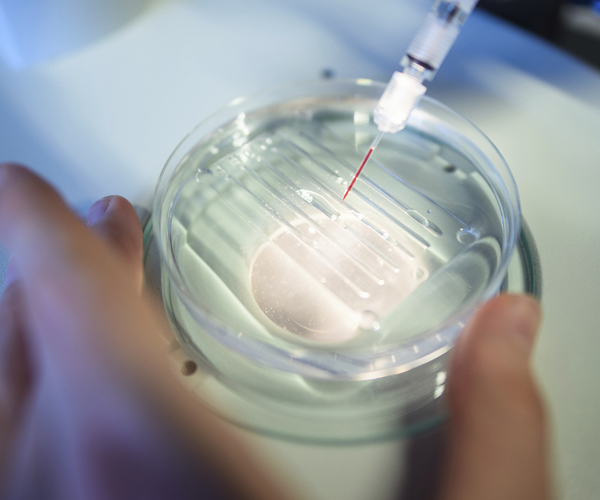Breakthrough: Gene editing creates ‘Designer’ cells that fight cancer
From Newsmax

n a first, scientists have used gene-editing technology to create “designer” immune system cells that can fight tumors and survive for months in cancer patients’ bodies.
It’s a proof of principle, the researchers say — and an early step toward bringing the gene-editing tool known as CRISPR into cancer treatment.
CRISPR allows researchers to precisely “snip” bits of DNA within a cell and make repairs to a flawed gene or perform other alterations. For years, scientists have been developing and studying CRISPR in the lab, in part to better understand the genetics underlying various diseases.
Ultimately, though, researchers hope to use the technology to cure diseases caused by specific genetic mutations — or, in the case of cancer, to genetically arm the immune system to fight the disease.
The new findings, published online Feb. 6 in Science, come from the first U.S. trial to test CRISPR gene-editing in humans.
“The goal here was to see if this is safe and feasible. Can CRISPR live up to its hype?” said senior researcher Dr. Carl June, a professor of immunotherapy at the University of Pennsylvania, in Philadelphia.
The initial findings suggest the answer is “yes,” he said.
The researchers were able to use CRISPR to make several specific gene edits in T cells taken from three cancer patients; T cells play a critical role in the immune system response. The modified cells were then infused into the patients, where the cells survived for months.
Finally, when June’s team took samples of the T cells from the patients’ blood, they found the cells were still able to kill tumor cells in a lab dish.
Experts cautioned that much work remains.
“This research is just out of the gate,” said Dr. Catherine Diefenbach, an associate professor at NYU Langone Health’s Perlmutter Cancer Center in New York City.
“The technology is exciting. This is a new way of engineering T cells to recognize tumor cells, but all they’ve shown here is that they can infuse these cells into patients, and no one got hurt,” she said.
“This is nowhere near ready for prime time,” added Diefenbach, who is also with the American Society of Clinical Oncology.
The use of T cells to fight cancer is not new. An approach called CAR T cell therapy is approved in the United States for some aggressive blood cancers. It involves removing a patient’s T cells and genetically tweaking them to sprout specific receptors on their surface. Once they are infused back into the patient, the receptors help the T cells find and destroy tumors.
But current therapies have major limitations, said Dr. Jose Conejo-Garcia, chair of immunology at Moffitt Cancer Center in Tampa, Florida.
CAR T cells only work well against blood cancers, he explained: “Solid” tumors in other types of tissue suppress the immune response against them.
In this study, June’s team used CRISPR to make three edits. The first two removed natural receptors from the T cells, so they could be reprogrammed to produce a synthetic receptor designed to help them seek and destroy tumor cells. The third edit removed a protein called PD-1, which can inhibit T cells from doing their job.
The ability to remove PD-1 “paves the way for a new generation of ‘super T cells'” that might overcome the immune-evading tricks of solid tumors, according to Conejo-Garcia, who was not involved in the research.
“Transferring genetically modified T cells is not new,” he said. “However, manipulation of multiple genes to achieve superior anti-tumor activities represents a breakthrough in the field.”
But everyone cautioned that all this study demonstrates is that the multiple gene edits are possible; the resulting T cells can survive in patients’ bodies (with the longest follow-up being nine months in one patient); and, in the lab, they can kill tumor cells.
A critical question is: Can the edited cells do harm? Here, the researchers saw no major side effects.
But, Diefenbach stressed, much more work is needed to assess the tactic’s short- and long-term safety.
A general concern with CRISPR, June said, is the potential for “off-target” effects: Could the edited genes end up affecting the activity of other genes?
Another is chromosome “translocation” — where a piece of chromosome breaks off and attaches to another chromosome. (Translocations are a cause of some cancers.) That did happen in the T cells June’s team engineered, and some translocations persisted in patients’ bodies. But over time, June said, the frequency of those rearrangements dropped as the T cells expanded and proliferated in the blood.
The ultimate question is whether CRISPR-edited T cells can actually beat cancer back.
June predicted that it could be a decade before any such treatment advances to the point of approval.
© HealthDay
For more on this story go to; https://www.newsmax.com/health/health-news/gene-editing-crispr/2020/02/07/id/953105/?ns_mail_uid=6952f1f9-507d-4a20-8cc0-0a1db158d76e&ns_mail_job=DM86813_02072020&s=acs&dkt_nbr=010102z78ykd





